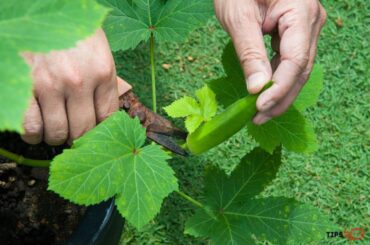How to treat orchid root rot? That is a question with an answer and you can find the answer in this article.

Orchids are one of the mandatory selections among houseplants enthusiasts. They would love to have these elegant beauties in their vicinity due to their luxurious long-lasting vibrant blooms. Some might think it would be a tedious challenge to care for orchids but this is not so true.
If you know the basics, caring for orchids won’t be tricky for you.Orchids are epiphytes or simply they are air plants. That means rather than being soil-bound, they love to grow above the ground level possibly upon another plant or object. However, they still require water and nutrients to thrive.
Root rot is one of the most prevalent problems that most orchid plant parents encounter which often resulted from too much water for the plant. If you are here to learn how to rescue your orchids from this terrible disease, yes you have come to the right place.
Can I save an orchid with root rot?
Well, with immediate actions in the initial stage of the disease, yes you can save your plants from dying. As the name implies root rot is a disease caused by numerous fungi to rot and decay the plant roots.
The disease can kill your plant within a short period of time unless you give it an emergency core. Probably, orchids’ roots are not visible once orchids grow in terra-cotta or ceramic pots unless you grow them in transparent plastic containers.
Thus, the roots remain hidden inside the potting mix. For this reason, most of the time root rot disease won’t be identified in advance. If you suspect your plant is ill, check its root system first. If you have used an opaque pot for your orchid, you should move some growth medium away to reveal the roots.
If you notice the roots are darker green than usual or brown, there is still a chance to save your plant but, if you wait until the roots become black and soft, it will be a tremendous amount of work for you to save your plant since the disease has come to its severe stage at this point.
So, most importantly it is crucial to take corrective actions as soon as possible once you diagnose the disease.
Reasons for orchid root rot
Waterlogged roots due to poor drainage and overwatering and also lack of aeration are the main reasons for orchid root rot. If your orchid pot does not facilitate drainage water or moisture can remain inside the pot for a prolonged period of time.
Similarly, if you water your orchids exceeding their actual requirement continuously root rot won’t be avoidable. Though orchids love to grow in a moist environment their growth can be impaired due to too much water.
Another reason for root rot is poor aeration. Lack of free space between the root system and the growing medium discourages the gas exchange between the roots and air making roots suffer. This is possible if the growing medium is so compact.
It will reduce the free air spaces inside the pot. Furthermore, this will again interfere with water drainage so, water tends to stay around the root zone for an extended period of time.
Once the above conditions are met, fungi pathogens can easily invade the root system making your plant ill. In fact, a number of fungal pathogens are responsible for root rot.
Usually, fungi and their spores are naturally occurring anywhere. You won’t get rid of them unless you create a sterilized space for your plants but this is not practical once you grow orchids in your home, not in a lab. Once they land on suitable substrates they start to multiply. If this happens, there will definitely be consequences.
If you have a diseased orchid plant (other than root rot) still there is a risk of getting infected with root rot. Sometimes, disease conditions like stem rot also lead to root rot. Though such pathogens appear on the aerial parts of the orchid they can eventually move towards the root zone to create the disease.

Orchid root rot symptoms
A healthy orchid root appears as a greenish fleshy core wrapped with a silver or whitish outer layer called velamen. Typically, roots are hard and dry. Once you water orchids you may have seen most of the roots appear in a light green hue. That’s completely normal.
This happens due to the water absorption by the velamen. The roots will turn their normal appearance again once they are dry. However, if you notice that the roots keep appearing in dark green color, indeed it indicates your orchid has been infected with root rot.
If you do not take immediate action, within a few weeks the roots gradually turn brown and then black and become soft. Actually, dark green roots are the first indication of root rot. If you further leave the plant inattentively, definitely you will see the consequences.
Remember that the symptoms do not appear at the first glance. You should be vigilant about your orchid. Since roots stay buried, it will be difficult for you to identify the disease in advance. Anyway, the orchid will give clear signs of the infection with a wilted and yellowish look at the later stage of the infection.
With the progression of the disease, you will see the changes in the aerial parts of the plant. Due to the rotting of roots, the plant will no longer be able to absorb nutrients and water hence it will give indications of dehydration and nutrient deficiency.
Yellowing and curling of leaves
Healthy orchid leaves are firm and green in color. However, due to the root rot, the leaves will become soft, yellow, and curled. It will be difficult for the plant to sustain so the leaves will turn yellow as a result of the degradation of biochemical components.
Drooping leaves
Since the roots cannot suck up water and nutrients from their growing medium, the orchid will be unable to satisfy its energy and water requirement. Therefore, the leaves become wilted, drooped, and finally fall off.
Shedding flower buds
You can see the dropping of newly formed flower buds from the diseased orchid plant. This happens because the diseased plant won’t be able to nourish the buds anymore, so they will easily fall off from the spike.
Stunted plant growth
As already mentioned, roots are not potent to take up enough nutrients from the soil to grow. As a result, you will see your orchid struggling to grow. The application of fertilizers may not help you to recover your plant until you give proper treatments to save it.
How to treat orchid root rot
You must take proper steps to treat your diseased orchids as soon as possible unless you want to see them dying. As mentioned earlier, it is very much essential to treat the plant at the initial stage of the disease in order to save your plants. If you don’t know how to deal with root rot, follow these tips to rescue your plant.
01. Remove the plant from the pot
Once you notice the roots of your orchid plant have shifted the color, do not be late to take the plant from the pot immediately. You know your plant has sat in excess water for enough time to get the disease. In addition, the substrate possibly holds a high pathogenic load.
Be mindful that implementing treatments for the disease while keeping the plant in the same potting medium will not going to help you to get rid of this disease.
Gently take your infected plant out of the pot. You can use a blunt tool to lose the potting medium to take the plant out without damaging its roots.
02. Clean the root
Once you take the plant out, lose the root ball with your fingers and expel all the soil carefully away from the root system. Then keep your orchid plant on a clean surface for further treatments.
03. Clean your tools
It is necessary to prevent the spreading of the disease from infected roots to healthy roots. So, you are supposed to trim the rotten roots of your plants. Before doing it is crucial to clean your utensils in order to prevent any cross-contamination.
You can disinfect your pruning shear and other tools with Lysol, phenol, or any other household disinfectant, rubbing alcohol, or bleach. If not, just immerse your tools in boiling water for a while. Thereby you can destroy any harmful pathogens that might present on your gardening tools which can cause problems in the future.
04. Trim rotten roots
The next step is the removal of contaminated roots. Trim black and mushy roots from your plants. Use a sharp gardening shear or scissor to do this. Make sure to sterilize your scissors after each cut to avoid spreading of pathogens. Simply you can spray the sterilizing mixture on to the cutting tool to remove any fungi attached to it.
05. Remove rotten roots properly
Double-check that you have trimmed all the detrimental roots from your plants. Do not let the plant touch the roots that you trimmed off the plant. Discard those roots in a proper way as they are not going to create a mess for any other plant in your yard.
06. Use fungicides
Fungicides are well known for effectively controlling fungal diseases. Thus you can treat your plant with a proper fungicide to fight against any remaining fungi and their spores.
If you diagnose the disease early, you can use a protectant fungicide such as Terrazole, Turban, or liquid copper fungicide. Anyway, if you were unable to diagnose the disease early, the use of protectant-type fungicides might not be effective as the disease has already progressed.
Therefore, in such a scenario the use of a systemic fungicide such as Subdue or Aliette is ideal. However, the application of Physan 20, Dithane M-45 and Captan (contact fungicides) is also recommended. You should follow the directions on the label during the application of the fungicide.
07. Keep until dry
Once you apply the fungicide keep the plant on a clean surface. Lay down the plant on a newspaper or on a cloth and let it dry. The time taken to dry the soil may depend on the environmental conditions.
It will take less time to dry when the environment is hot and dry. If you feel the roots of the plant are dry now it is the time to replant your orchid.
08. Get a new pot
If possible you can use a new clean pot to house your plant. If you don’t have a new one don’t worry you can use the same pot.
If you wish to use the same pot, make sure to disinfect it properly. You can use the similar disinfectant that you used to clean your gardening tools to clean your pot as well.
However, it would be better if you select a new pot that is quite larger than the previous one. If the pot is not enough for your plant, due to poor aeration inside the pot you will face a similar incident in the near future.
For orchids, it is important to use a free-draining pot. You can select a pot with holes or slits to promote drainage as well as air circulation.
09. Repot the plant
First, add a little amount of potting medium as it covers the bottom of the pot. The common practice is to fill 1/3 of the pot with the potting medium. Place your orchid in the pot and add the potting medium a little by little. Use a chopstick or fingers to settle the medium around the root zone.
Do not use the same potting medium you used previously. You can prepare your own potting mix by combining some porous yet hard materials such as coco chips, fine fir bark, perlite, and wooden charcoal. Other than that you can purchase a potting mix intended for orchids.
Most importantly, try to provide a substrate that favors the drainage and good aeration to keep the orchid roots happy and healthy.
10. Place in a sunlit area
Keep your orchid as it exposes plenty of bright indirect light. Do not open the pot to direct the sun as it can stress and burn the plant. Keep the plant near a window. East-facing and north-facing windows are ideal to keep your orchids as the plant gets enough mild skylight through them.
South-facing and western-facing windows are not advisable as the plant may be exposed to direct harsh sun. Be assured that the plant is not burnt in the sun especially if you keep it on the windowsills.
11. Proper watering schedule
If you can remember, root rot often resulted from overwatering. Therefore, you have to have a proper watering schedule to prevent the occurrence of the disease again. When it comes to watering orchids, watering the plant only when the growing medium is nearly dry is the recommendation.
So, just feel the dampness of the soil before watering your orchid. Ensure the roots never sit in soggy soil for a long period of time. In general, it is okay to irrigate your orchids every seven or ten days.

How to treat orchid root rot in recently planted orchids?
If you diagnose root rot in recently planted orchids, there are several important things to consider.
Alter the growing medium:
If your newly planted orchid shows the symptoms of root rot, it indicates that the potting mix is not suitable for the plant. The orchid potting medium should not be dense as it discourages the free-drainage and air circulation.
Typical potting mixes are not suitable for orchids as they are dense and tend to hold more water. Though they are suitable for soil-bound plants they won’t work for epiphytes like orchids.
Addition of some materials that creates enough air pockets in the medium will help you to control the disease. Check the size of the components you used to prepare the medium. If they are too small, they will be packed closely and won’t create enough free space inside the pot putting your orchid at risk.
Change the orchid pot:
Not only the substrate, sometimes the pot can even be a reason for your orchid getting sick. The pot should be of sufficient size and contains holes to facilitate drainage.
If the pot is too small, it will not hold enough potting mix and obviously enough water. Therefore, you may have to water the orchid frequently, leading your plant to become sick. Use a pot 1 to 2 inches wider than the previous pot to repot your orchids.
Give a proper place to your orchid:
Spot your orchid pot where there is ample light and good ventilation. Orchids need bright light to stay healthy. So, skip dark and shady corners to keep your orchid pot. Always provide a bright area for your plant to keep the detrimental pathogens away.
Windy areas ensure good airflow around the plant. This does not mean that you have to place your plant in a highly windy place. Ideally, place your orchid near a window. The air around the orchid should not be stagnant.
Warm temperatures also encourage plants’ health. Due to the warmness, the potting medium will dry easily. That will also help you to control the disease.
Orchid Root Rot Cinnamon
Cinnamon is a good option as a homemade fungicide, especially for those who are reluctant to use synthetic chemicals for their plants. Cinnamon has proven antimicrobial properties that can be useful to control diseases including but not limited to root rot.
A thin layer of cinnamon powder should be applied on the cut ends of the roots. Anyway, you should never apply cinnamon to healthy roots because cinnamon can make the roots dry severely.
Related questions
Should I cut dead roots off my orchid?
Yes, if you are certain, you can trim dead roots from your orchid. Unless your plant is not infected with brown rot or black rot you can trim the dead roots when repotting the orchid. However, if your plant is sick with root rots you should never hesitate to trim the dead roots to save your plant without worsening the disease.
Whenever you trim the roots, make sure that you’re using sterile gardening shears. Further, be careful not to damage healthy roots and the plant stem when you trim the roots.
Does peroxide help root rot?
The most straightforward answer to this question is yes peroxide helps root rot. Before applying peroxide, remove your plant from the pot and pull out all the soil. Remove all the rotten and dead roots leaving only healthy roots in the plant. Spray 3% hydrogen peroxide (H2O2) to the root system thoroughly.
Hydrogen peroxide is a popular antifungal agent. It kills fungi cells by destroying their cell walls. Other than that, peroxides can give excess oxygen to the roots. This will boost the healing process of the orchid.
It is crucial to check the concentration of the peroxide solution before applying it. In fact, 3% H2O2 is ideal to treat your plant. Higher concentrations may be harmful. Thus, dilution prior to use is essential.
Can an orchid live with only air roots?
Orchids are air plants. In the wild, rather than growing on the ground, they grow on the surfaces of trees. Orchid roots do not like to dig into the soil, instead they love to live in the air. These aerial roots absorb moisture and nutritious elements from the air.
Furthermore, apart from the leaves, aerial roots also contribute to photosynthesis which helps gain the energy needed for plants to grow. Some aerial roots help the orchid to hang on to the plant so it will be safe from winds and heavy rains. But once we grow orchids in our home space we have to pot or mount them.
In rainforests, plenty of nutrient elements consistently move along with the wind currents so the orchids can readily use these nutrients for their growth and development. However, this is not the same scenario when orchids are grown as houseplants since nutrients are not that much available in the air.
So that, whether orchids are grown indoors or outdoors, roots won’t take enough nutrients from the surroundings if there are aerial roots only. Therefore, we have to pot the orchids to provide sufficient nutrients for the growth and development of the plant.
What does root rot look like?
Take out your orchid from the soil and reveal the root system. If the roots look dark green, dark brown, or black and soft at the touch, probably the plant is suffering from root rot. In addition, you will see the growth stunting, yellowing of leaves, and dropping of lower leaves and flower buds in the infected plants.
What is the best potting mix for orchids?
Medium which promotes free-draining, and aeration and also provides nutrients to thrive is best for orchids. Usually, orchids prefer chunky media to be rooted in. You can easily prepare such a medium by mixing equal parts of perlite, bark fines, and peat moss.
The sizes of the pieces should be sufficient enough to create ample air spaces between the roots and the medium. When it comes to the pH level orchids crave slightly acidic soil so the pH should be between 5.5 to 6.5. Such a level of acidity helps nutrients to dissolve to readily absorb by the plant.
Read Next : Orchid Water Tubes | Keep Them Fresh Longer |




